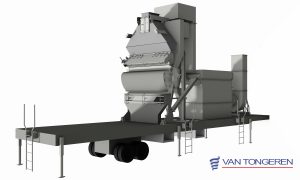Air Classifiers
Air Classifier Systems
Van Tongeren developed three models of air classifier in 1958, using knowledge of air flow gained through the earlier development of cyclones. The equipment is used to classify particles into different size ranges (as opposed to a cyclone, which is designed to collect particles of all sizes).
The three models were the gravitational, the gravitational inertial, and the centrifugal. The appropriate air classifier for a given application will depend on the properties of the particles to be separated.
Van Tongeren air classifiers keep the material dry, as opposed to wet classification methods which require additional drying, so the product may be used directly.
These air classifier designs contain no moving parts and require less maintenance than “whizzer” type equipment, which can require a significant amount of maintenance – particularly in the dusty environments where this equipment is typically used.
- Gravitational Air Classifier
- Gravitational – Inertial Air Classifier
- Centrifugal Air Classifier
- Mobile Air Classifier
Gravitational Air Classifier:
- Works by passing a current of air through a curtain of falling material.
- Fine particulates are swept up in the current of air while the coarse material continues to fall out the bottom of the classifier
- Used to separate fines less than 150 mesh to 150 microns from more coarse material
-
- Product dedusting
- Minerals processing
- Potash
- Salt
Gravitational – Inertial Air Classifier:
- Works by passing a current of air through a curtain of falling material and then recirculating the entrained fines back through the curtain of material.
- Used to separate fines between 300 and 36 microns from more coarse material
-
- Product dedusting
- Manufactured sand
- Minerals processing
- Potash
- Diatomaceous earth
- Salt
- Fertilizer
Centrifugal Air Classifier:
- Works by using the centrifugal force on the larger particles to make them flow along the baffles in the classifier. Transport air then passes through a curtain of the circulating particles as they sweep off the baffles edge. A secondary air stream is introduced lower in the classifier to sweep any uncollected fines out of the coarser material
- Used for separating material from 100 microns to 15 microns from more coarse material
-
- Product dedusting
- Flyash
- Minerals processing
- Fertilizer
Mobile Air Classifier:
Van Tongeren has developed a mobile classification system which is employed on manufactured sand projects where multiple sites may be involved. The whole plant fits onto a standard truck base and utilizes a set of Van Tongeren high-efficiency multicell cyclones for exhaust gas clean-up.

Each of the above air classifiers can be used in series to split feed into various products. They are generally followed up by a cyclone or bank of cyclones for additional fine particulate removal. A final piece of particulate removal equipment – such as a bag house or cartridge filter – is added to meet pollution control requirements.
